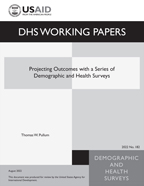There is no printed copy available to order.
Abstract:
A series of Demographic and Health Surveys (DHS) in the same country is often used to describe trajectories of continuity and change in many types of outcomes. Successive surveys are also compared to monitor short-term changes and to identify inconsistencies that may be related to data quality. In this paper, earlier surveys in a specific country are used to generate expected levels of outcomes in the most recent survey. Because projections are generally based on an assumption of continuity in underlying processes, deviations from projected values can suggest changes in those underlying processes. The procedure is applied to six major outcomes that are measured by DHS. Some outcomes are simplified slightly, so they can be described as binary, or counts, or rates. Virtually all DHS outcomes fall into one or another of these types. In six countries, models are applied that use one or two earlier surveys to produce expected values in the most recent survey. The single-survey model assumes that change in an outcome is only due to multivariate change in composition on the standard DHS background variables, plus some additional covariates. The two-survey model adds a linear time effect and an assumption that the rate of change between the two previous surveys has continued to the current survey. In addition to national estimates for each country, the model produces estimates for strata (combinations of region and urban/rural residence) and the age interval of the woman/mother. The observed values in the most recent survey may be very close to the projected values. However, the suggested utility of the procedure is not to forecast current values, but to help analysts see how countries, strata, or age groups may have deviated from the underlying assumptions. Researchers can then attempt to understand why a time trend has not continued, or has accelerated, and why some strata differ from the national trend. Such efforts would focus on a specific outcome in a specific country and lie outside the methods described here.
 Projecting Outcomes with a Series of Demographic and Health Surveys (PDF, 3591K)
Projecting Outcomes with a Series of Demographic and Health Surveys (PDF, 3591K)
